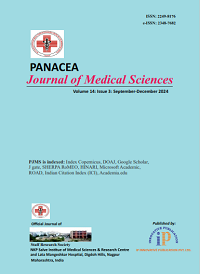Bone tumours of the skull: Spectrum of 12 cases with review of literature at tertiary centre in Jaipur
DOI:
https://doi.org/10.18231/pjms.v.15.i.1.18-24Keywords:
Skull tumors, Malignant or benign tumours, Brain metastasisAbstract
Introduction: Skull tumours are usually a mass present next to or inside the skull bones and are benign or malignant and may present with symptoms or exist asymptomatically when diagnosed incidentally. The diagnostic and management options for patients with skull lesions start with complete history and general examination with proper analysis of anatomical location. Appropriate neuro-imaging involving MRI, CT or vascular modalities are used which further refine the differentials of various types of tumours. Materials and Methods: This is a descriptive observational and cross sectional study done in 15 patients with skull tumours in department of neurosurgery, SMS Medical college and hospital, Jaipur in the academic year: 2022-2023. The clinical history, examination and diagnostic neuro-imaging along with histopathological correlation was studied for reporting of series of 12 cases of skull tumours. Results: We identified 12 cases of bony tumours of the skull. It was observed that benign tumours (41.7%) were more commonly present than malignant (25%) and intermediate grade (33.3%) ones. The frontal bone was the most common location (66.7%) followed by occipital bone (16.7%). The most common benign tumour was found to be osteoma (25%). Fibrous dysplasia showed intermediate malignant potential and seen in highest proportion in our study (33.3%). Among Malignant tumours, Ewing’s sarcoma was seen in one patient (8.33%) and predominant metastasis in adults with higher age group and in higher proportion (16.7%). Conclusion: Documentation of systematic series of skull bone tumours is an essential tool in analyzing the differential diagnosis of tumours based on their characteristics of age, sex and location. This case series provides a collective concord for better management of patients. Identification of skull tumours is aided by distinguished use of immuno-histochemistry along with molecular studies and neuro-imaging techniques.Downloads
Published
2025-03-12
Issue
Section
Articles
How to Cite
Bone tumours of the skull: Spectrum of 12 cases with review of literature at tertiary centre in Jaipur. (2025). Panacea Journal of Medical Sciences, 15(1), 18-24. https://doi.org/10.18231/pjms.v.15.i.1.18-24





